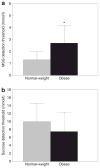Obese women have lower monosodium glutamate taste sensitivity and prefer higher concentrations than do normal-weight women
- PMID: 20075854
- PMCID: PMC2987588
- DOI: 10.1038/oby.2009.493
Obese women have lower monosodium glutamate taste sensitivity and prefer higher concentrations than do normal-weight women
Abstract
The goal of this study was to determine whether obese women exhibit altered umami and sweet taste perception compared to normal-weight women. A total of 57 subjects (23 obese and 34 normal weight) participated in a 2-day study separated by 1 week. Half of the women in each group were evaluated using monosodium glutamate (MSG; prototypical umami stimulus) on the first test day and sucrose on the second test day; the order was reversed for the remaining women. We used two-alternative forced-choice staircase procedures to measure taste detection thresholds, forced-choice tracking technique to measure preferences, the general Labeled Magnitude Scale (gLMS) to measure perceived intensity of suprathreshold concentrations, and a triangle test to measure discrimination between 29 mmol/l MSG and 29 mmol/l NaCl. Obese women required higher MSG concentrations to detect a taste and preferred significantly higher MSG concentrations in a soup-like vehicle. However, their perception of MSG at suprathreshold concentrations, their ability to discriminate MSG from salt, and their preference for sucrose were similar to that observed in normal-weight women. Regardless of their body weight category, 28% of the women did not discriminate 29 mmol/l MSG from 29 mmol/l NaCl (nondiscriminators). Surprisingly, we found that, relative to discriminators, nondiscriminators perceived less savoriness when tasting suprathreshold MSG concentrations and less sweetness from suprathreshold sucrose concentrations but had similar MSG and sucrose detection thresholds. Taken together, these data suggest that body weight is related to some components of umami taste and that different mechanisms are involved in the perception of threshold and suprathreshold MSG concentrations.
Conflict of interest statement
The authors declared no conflict of interest.
Figures



References
-
- Ikeda K. New seasonings. Chem Senses. 2002;27:847–849. - PubMed
-
- Beauchamp GK. Sensory and receptor responses to umami: an overview of pioneering work. Am J Clin Nutr. 2009;90:723S–727S. - PubMed
-
- Donaldson LF, Bennett L, Baic S, Melichar JK. Taste and weight: is there a link? Am J Clin Nutr. 2009;90:800S–803S. - PubMed
-
- Potier M, Darcel N, Tomé D. Protein, amino acids and the control of food intake. Curr Opin Clin Nutr Metab Care. 2009;12:54–58. - PubMed
Publication types
MeSH terms
Substances
Grants and funding
LinkOut - more resources
Full Text Sources
Other Literature Sources
Medical

